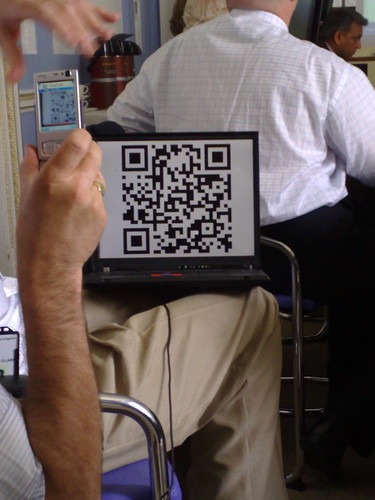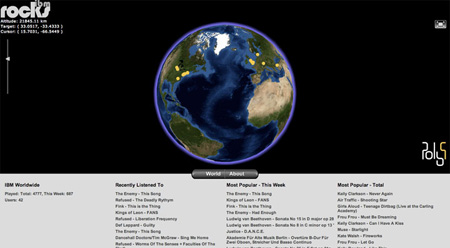You may have noticed a good few references to another pet subject of 3d printers here on eightbar. Well here is another one.
Mcor use the principle of printing out layers of paper that are then bonded together to create a 3d model. That is a really interesting approach, especially given the lower cost of paper versus the plastic based printers.
The other interesting point is the way I got introduced to this. Guy Kawasaki, one of the original evangelists posted it on twitter refering to his truemors website. I follow his twitters and saw 3d printer, so it was a natural conclusion to then post it on eightbar.
Category Archives: Technology
Performing, showing off ,positive feedback and recycled content
Back in august over on terranova I wrote a post “What a performance Live Vs Recorded in a multi player world” I have been revisiting the concepts around performance and the ability to interact with people and content in a live sense even more.
The driver for this has been two very interesting mainstream games. Guitar Hero (now at version iii) and Singstar (the PS3 version). The premise behind both these games is as players and users we interact with existing content but add a performance element to that interaction. Guitar hero uses a seemingly amusing plastic guitar, using the buttons on the guitar an pushing the strumming button you are able to play along with songs. The peripheral based bemani (short for beat mania) where you provide responses in time to some sort of music and on screen prompts comes in all sorts of shapes, the dance mat games, bongos, maracas, you name it.


Also Singstar uses the same principle but instead of pressing buttons to a beat and the tune coming out accordingly it has mics and you sing along with songs. You get a visual feedback of how in tune you are. I had been writing about this over on epredator.com too as its had some surprising results

The point that struck me is that people, normal people not gamers, can see and hear the results of a players performance and really understand if someone is good or bad or just trying very hard. Most things we all do, especially in the tech world are under the covers or obscure enough that people do not understand the artistry. Even regular games, non-gamers will see the top player in the world dispatch several enemies with a single shot before dashing to a new point of cover, and it will look easy. Only other game players see the skill.
These bemani performance games highlight mistakes, highlight perfection but in a field that most people can relate too. In many ways this is reflected in the virtual worlds and metaverses. Here people are starting to see the skill of the build both from trying themselves and also from relating to real life.
If we can make live performance and skills in a business context as identifiable as a good singer on singstar, combined with the ability for people to have a continuous way to practice and refine I think we have some really good results. I am by no means a singer, but I now appreciate the structure of some of the songs I have been singing at a much deeper level than a pure passive listener. It is this ability to delve deeper into existing content, e.g. mr brightside by the killers on Singstar or Anarchy in the UK on guitar hero III, also having repurchased the content for its enhanced involvement. All that music back catalog, fighting to deal with file sharing and without a moments thought I was more than happy to spend another 99p to buy a Singstar version of a Duran Duran song that I am sure we already have on multiple CD’s and MP3 playlists.
So we get to understand content by immersing in it in a very public way and people get to understand our various talents through seeing the performance. It seems an interesting pattern?
Yet more 3d printing – getting cheaper
Fellow eightbar member and Creative Director Brian Peaston pinged me today with some fantastic links.
The first is to Desktop factory which by its very name shoudl give the game away. Desktop rapid fabrication with a 3d printer. A 3d printer for $5000 thats quite a significant price point. Maybe I should sell my Second Life islands, as we now have plenty, and buy one of these now. Its getting very close ot being normal. At this price its looking veyr promising.
The other is very related and a good looking service in principle. Ponoko is a service that lets you build things and get them made, and then sell patterns to others. Now this is sort of local to this site, but it is veyr very long tail. I will be signing up and having a go. Who knows I may build all the xmas present this year 🙂
In the presence of….
At the analysts conference here in Lisbon it turned out that Jeff Jonas, a bona fide internet celeb was also presenting a stack of 1:1 sessions. I had not read name tags but he was hanging with monkchips.
Now I often talk about the clever its of entity analytics, in particular the fact that the fact you ask a question of a dataset is data itself. A very clever and obvious idea, once you hear it. So ask a question and get ‘no’, someone else asks the same question and “hey something is going on here” a massive over simplification but worth thinking about. I will leave it to Jeff to do his thing.
So Grady Booch and Jeff Jonas have both had the pleasure of epredator’s company the last the few weeks. It feels like fanboy time 🙂
The really interesting thing though is Jeff’s articulation of left column thinking here, take a look and shout, oh that’s eightbar turf !
VWF pre-conference workshop
Both Ian and I are (for once) in the same place for much of this week at the Virtual Worlds Forum conference. I’m actually speaking at the ‘harnessing enterprise virtual worlds‘ pre-event workshop today, as part of the following lineup:
- Steve Prentice (Gartner) – What are enterprise virtual worlds?
- Ron Edwards (Ambient Performance) – Harnessing the advantages of enterprise virtual worlds
- Dele Atanda (Diageo) – Case study (their work in Second Life with Rivers Run Red and IBM)
- Roo Reynolds (IBM) – Building a community within a (big) company
- Chris ‘Satchmo Prototype’ Carella (Electric Sheep Company) – Understanding the human factor
- Sara De Freitas (Serious Games Institute) – The impact on education
Here are my slides. I’ll try to add the audio track later today. You might want to open the presentation itself and click the “comments on slide x” tab to see the speaker notes.
A nice warmup for the conference and it was really good to meet Chris/Satchmo face-to-face for the first time.
Pieces of eightbar – Talk like a pirate day
It would be wrong to have ignored talk like a pirate day with a wonderful pun like “pieces of eightbar” just asking to be used.
We get everywhere dont we 🙂 Avast ye virtual land lubbers etc….

LastFM + IBM = IBM Rocks
Psssst! Ian’s away on holiday and I can’t see Roo, so I’m going to hijack eightbar and write about something none virtual worlds related.
There’s a competition running inside IBM at the moment, it’s to develop a situational application (mashup) using some of the data feeds available on our Intranet. Lots of people here listen to music while they work and being a nerdy population, they also tend to use LastFM. So why not show the music that’s being listened to at different IBM sites across the world? That’s what IBM Rocks does.
It takes feeds from our internal directory system (bluepages) and our site location database (RESO) , merges them with LastFM feeds and displays them on a Poly9 3D earth. Pretty simple really, not much business value (so we wont win the competition), but it looks pretty.
Being disruptive is a good thing
Today I was on a roll with the final virtual worlds pitch of the week in the company of two of Hursley’s Distinguished Engineers(DE), Mandy and Andy. Both of them are known for being great innovators and mentors a like and have a proper standing in our technical community based on doing things.
I did my new Virtual Worlds pitch to a very knowlegable audience of visitors. Evangelizing as I do it is good to have a positive discussion rather than having to always convince the odd doubter in the crowd.
On after me was Mandy talking about the problems of free thinkers and innovators within traditional management structures of any organization. Much talk of comfort zones, motivations and measurements.
I twittered a few times that many of the phrases and examples of an attempt to control a free thinker were almost identical to the ones I have heard more than once during my career. The gist of the presentation is that if you do not pay attention to people and their new ideas and merely seek to control and tell them what to do then the true innovators peronality types will either leave, give up or become subversive.
Part of the make up of some of the people that can be regarded as causing trouble/innovators is an apparent lack of attention, as new things come around and they get focus. Which in a traditional task based management structure is obviously hard for some people to manage or deal with.
The irony of that was that Andy and I were at the back of the room trying out something Andy was putting together. So it may have seemed we were not paying attention. In reality we were helping Mandy by demonstrating the very traits that she was discussing. This is very different from people just ignoring the presenter and doing their emails.
So what was Andy SC up to ? He too has got a Nokia n95 recently, though his came with his elevation to DE 🙂 As an inventor and leader in all things pervasive he was exploring the barcode/QR code reader software whilst creating a few messages with some QR code creator software.
He was showing it to me when I decided to flickr it live via the phone in a wheels within wheels type of way.
I should also point out that Andy was introduced to QR codes by Dave Conway-Jones our pervasive guru who has usually seen, implemented and moved on, with most of these things before we have even got to them.

I dont think Mandy was too upset as it was a quick burst of energy and as we broke for lunch everyone asked what it was. By that time it was a QR code clock, not unlike his TimeFrame in Second Life
Now, next comes a Second Life implementation, prims or textures?
More worlds colliding ustream twitter and Second Life
This morning I have on one screen Eric Rice’s ustream broadcast from within Second Life. In another window Twitter, which is what caused me to click, and I am also in Second Life.
All the channels are feeding me perspectives. I can hear Spin talking, see where is going, but also join in on some Sim’s where appropriate.
It feels like a major convergence point.
So check out ustream.tv
PlayStation Home and LittleBigPlanet – Sony keynote at GDC introduces ‘Game 3.0’
I know I’m not the first blogger to mention this (even on Eightbar I’ve been beaten. Twice. ) but… Sony’s keynote at the Games Developer Conference was pretty fascinating.
Opening by putting the future of the games industry in the context of Web 2.0, Sony introduced us to a new Noun X.0, ‘Game 3.0’. Apparently, it’s…
“all about the connected device … empowered by audiences and powered by dynamic content, powered by active communities built on open standards”.
Yes. Of course. Sony gets it. I especially the tip of the hat to open standards.
Later summarised as being a “new era of creativity, collaboration, communication and commerce” (4 Cs; I’m a sucker for a memorable soundbite), the biggest and best example given of ‘Game 3.0’ in action was Playstation Home. It’s an avatar-based 3D virtual world. Home is not a product, it’s a free service. In fact, it’s a “3D social networking service”. Home provides the user with a customisable avatar, and a user interface which includes a virtual PSP as part of the controller metaphor.
Each user will have access to both private and public spaces, as well as a personal hall of fame with 3D trophies (optionally involving video). Communication options include:
- quick chat (phrase choices)
- virtual keyboard (on screen keyboard.. “ho”)
- USB keyboard
- voice chat
- animations
All very nice. But where does the content come from then? Well, it’s a combination of premium content, which users will pay for, and free items that will be delivered by game developers, game publishers, and Sony themselves; the personalisation is delivered not through custom, or user generated content, but by provided content which is either purchased or unlocked by buying games.
Despite the heavy Sony influence in the 3D content used in the demonstration (which included dropping a Sony Bravia television down the stairs)…
“Home is not just about Sony brands and Sony games, it is a much wider network of connected spaces. … Individual spaces dedicated to either games publishers or to game developers or to individual titles.”
Just game content then?
Over time this will extend beyond the game arena to include non-game brands as well. So you can imagine a location built around a famous coffee company or a famous drinks company, clothing company, record company, retailer, magazine, you can get the idea as this will build out.”
Right. But how is the content created?
“This is very very simple to build. As game developers, as content creators you can reuse content that you’re designing for your own games. It’s all using Maya. It’s really simple to build the 3D spaces and we will be providing you with the tools and the SDKs to unlock this and to maximise this. Any surface can be tagged as video. Any surface can be powered by HTML pushed from websites, and you can have individual areas dedicated to games. The way you want to design it as developers is entirely up to you.” … “All of these things are really simple really easy really powerful ways to build community and socialisation around your game brands”
I still have this nagging question. What about user generated content? Am I wrong in thinking that part of what makes something like Second Life so popular is the freedom for every user to create anything they want? Sure, they might not all be builders, but Sony: why are you limiting the building to your partners? What about the creativity of the end users?
In the second half of the keynote we are introduced to LittleBigPlanet from Media Molecule (the makers of Rag Doll Kung Fu). I really like this. Seriously fun-looking play, with user content in spades. More words than I can write at videogamesblogger, joystiq, kotaku and more.
Now this is more like it. I’m sure the palette will still be a bit limited, but the community which will no doubt build up around this with users creating cool levels to out-do each other is going to be fun to watch.

